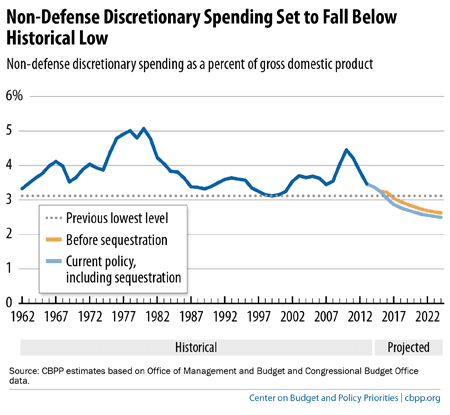BEYOND THE NUMBERS
House's Skewed Funding Choices Amidst Non-Defense Funding Squeeze
The House Appropriations Committee’s recent decisions on how to divide up the available money for non-defense discretionary programs for next year represent a poor allocation of insufficient resources, our new analysis explains. Here’s the opening:
The House Appropriations Committee recently adopted its fiscal year 2015 funding allocations for its 12 subcommittees. The allocations are consistent with the defense and non-defense discretionary funding caps set in last year’s agreement between Senate Budget Committee Chair Patty Murray and House Budget Committee Chair Paul Ryan. Despite that agreement’s partial relief from the sequestration budget cuts, the overall funding level is much tighter than many observers appreciate. Further, the House allocations to meet the tight non-defense cap reflect skewed policy choices, likely imposing deeper cuts on programs serving low-income populations and certain other priority programs than on other areas. These choices are particularly inappropriate in a period of rising inequality.
This analysis’ key findings are:
- Non-defense discretionary programs need to be cut below the last year’s appropriated levels to stay within the 2015 caps. The Murray-Ryan deal raised the 2015 cap for non-defense discretionary funding only a small amount above the sequestration level — but not enough to accommodate certain factors largely beyond the Appropriations Committees’ control (such as lower estimates of receipts from Federal Housing Administration [FHA] mortgage insurance) and funding increases already enacted for veterans’ medical care. Adjusting the 2014 enacted level for these factors, appropriations for other non-defense discretionary programs will need to fall in 2015 by more than $3 billion below the 2014 level. And the 2014 appropriations themselves were austere, since the Murray-Ryan deal canceled only part of sequestration in that year. Further, after adjusting for inflation, the cut is almost $14 billion below the 2014 levels.
- The House Appropriation Committee has targeted funding areas with key low-income programs for deeper cuts. To meet the 2015 cap, the House Appropriations Committee allocations impose the biggest dollar cuts on the two appropriations bills that cover health, education, housing, transportation, and human services. These bills include a high concentration of the non-defense discretionary programs that support low-income individuals. Given the deep cuts that virtually all non-defense discretionary programs have sustained in recent years, the choices Congress faces are difficult. But in 2015’s constrained funding environment, the pain should be spread more evenly; concentrating the cuts on low-income programs is highly inappropriate.
Of course, Congress could address the problem by funding non-defense discretionary programs at a higher overall level, but it does not seem inclined to revisit the 2015 cap levels set in the Murray-Ryan deal, so it will surely be forced to cut some programs that merit increases. Non-defense discretionary funding supports a diverse set of public services, ranging from environmental protection and food safety to veterans’ health care and border security. It supports investments that can boost future productivity, such as in education and basic scientific research, and helps low-income Americans meet basic needs and climb the economic ladder, such as through Head Start, job training, and services for frail elderly and disabled people.
The squeeze on non-defense discretionary funding will become even more acute in 2016. The Murray-Ryan agreement was a two-year deal that didn’t apply to 2016, so the full sequestration cuts remain in effect for that and subsequent years.
Image
In fact, non-defense discretionary spending in 2016 will fall to its lowest level as share of the economy on record, with data going back to 1962 (see graph). It will continue to fall as a share of gross domestic product (GDP) in years after that. Policymakers should consequently commit to providing relief starting in 2016, much as they did in the Murray-Ryan deal, in order to avoid severe cuts in key services upon which many Americans depend and important investments in the nation’s future.
